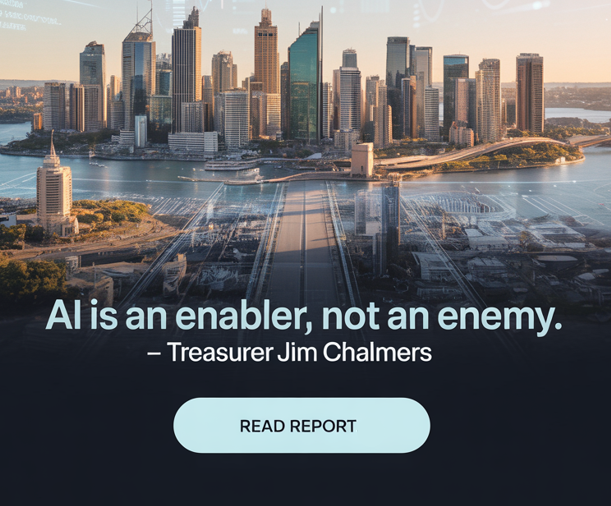Artificial intelligence is quickly emerging as one of the most powerful drivers of economic growth in Australia. With the federal government estimating a potential $200 billion boost over the next decade, AI is no longer just a technological breakthrough, it’s an economic imperative. Treasurer Jim Chalmers has called AI an "enabler, not an enemy," signalling a shift toward innovation-friendly policy. As debates continue around how best to regulate AI, investors are already moving. HALO’s AI Model, up 81% in the past 12 months, is capitalising on this momentum. Here's what you need to know and how you can get ahead.
AI Is Reshaping Australia’s Future: Are You Positioned to Benefit?

AI as an Economic Catalyst: Treasurer Jim Chalmers Champions Innovation Over Restriction
Artificial intelligence is no longer a distant concept. It is a present-day force reshaping global economies, disrupting traditional industries, and redefining the way governments and businesses approach productivity and growth. In Australia, AI is now at the centre of economic policy discussions, with Treasurer Jim Chalmers declaring it "an enabler, not an enemy."
This statement comes as the government prepares to host a national economic reform roundtable focused on productivity. The event will bring together key stakeholders from the public and private sectors to determine how Australia can best harness the potential of AI, while addressing the risks and public concerns that come with it.
AI has the potential to significantly transform the national economy. According to a recent report from the Productivity Commission, AI could contribute more than 116 billion dollars to the Australian economy over the next ten years. In more ambitious projections, this number could exceed 200 billion dollars, placing AI among the most transformative economic developments in recent history.
Australia Faces a Pivotal Regulatory Decision
The rise of AI presents governments with a difficult balancing act. There is pressure to introduce regulations that manage the potential harms of AI technologies, such as data misuse, algorithmic bias, and job displacement. However, there is also a growing consensus that overregulation could hinder innovation and limit the country’s ability to compete on the global stage.
One regulatory option under consideration is the creation of a standalone AI Act, similar to the one being implemented by the European Union. This approach would apply specific rules to AI systems based on their risk to individuals and society.
The Productivity Commission, however, has urged the government to pause such a move. In its latest report, the Commission recommended that the government avoid sweeping, economy-wide AI regulations until it has fully assessed whether existing laws are insufficient. The Commission’s core message is that regulation should only be introduced when it is necessary to address clearly identified harms that cannot be managed under current frameworks.
Treasurer Chalmers has echoed this cautious approach. He argues that Australia must take a “middle course” when it comes to AI regulation. According to Chalmers, the government should regulate as much as is required to protect the public, but not so much that it slows the pace of innovation or discourages investment in the sector.
The Economic Promise of AI
The report by the Productivity Commission makes clear that AI could be a key driver of economic growth. It estimates that the technology could increase Australia’s annual labour productivity growth by as much as 1.3 percentage points. This would mark a significant improvement over the 20-year average of just 0.9 percent.
Such gains would have far-reaching benefits for the broader economy, including stronger wage growth, higher living standards, and greater international competitiveness. As a result, AI is now viewed by the federal government as one of the most important tools for improving long-term budget sustainability and economic resilience.
That said, the Commission also highlighted some of the risks associated with AI. In particular, it warned that the technology could result in “painful transitions” for some parts of the workforce. As AI automates repetitive tasks and reshapes industries, certain jobs are likely to become redundant. According to the World Economic Forum, AI could displace up to 9 million jobs globally over the next five years.
This makes targeted investment in skills development, education, and job transition programs essential. Without such support, the economic benefits of AI could be unequally distributed, leaving some sectors and communities behind.
Building Public Confidence in AI
While AI is gaining traction in policy circles and capital markets, public sentiment remains cautious. Many Australians are unsure about the role AI will play in their lives and careers. Concerns around job loss, privacy, and ethical oversight remain common.
Policymakers and industry leaders now face the task of building public trust. This includes creating transparent regulatory frameworks, clearly communicating the benefits of AI, and showing how AI can enhance—not replace—human capabilities.
Treasurer Chalmers has been deliberate in his messaging, consistently framing AI as a tool for positive change. His focus on AI’s potential to drive productivity and improve public services is part of a broader effort to shift the national narrative away from fear and toward opportunity.
Investment Markets Respond to the AI Opportunity
While government policy is still taking shape, financial markets have moved quickly to embrace AI as a powerful investment theme. Around the world, AI-focused companies are attracting significant capital, with strong growth in sectors such as semiconductors, cloud infrastructure, machine learning platforms, and AI-powered enterprise software.
In Australia, one of the clearest examples of this momentum is HALO’s AI Model, which has generated an outstanding 81% return over the past 12 months, as of 7 August 2025. This model is part of HALO’s suite of thematic investment strategies and is designed to capture the full breadth of the AI ecosystem.
The AI Model provides diversified exposure to companies that are directly developing or enabling AI technologies, as well as those applying AI to transform traditional industries. These include firms in robotics, automation, data analytics, cybersecurity, and digital infrastructure.
By focusing on both emerging innovators and established leaders, the model offers investors a comprehensive way to access the long-term structural growth driven by AI adoption.
Why HALO’s AI Model Stands Out
What sets HALO’s AI Model apart is its focus on sustainable, research-driven growth. Rather than chasing short-term trends, the model uses rigorous analysis to identify companies with strong fundamentals, scalable technologies, and strategic positioning in the AI value chain.
Its impressive performance reflects not only the underlying strength of the AI sector, but also HALO’s ability to adapt to shifting market dynamics. As AI continues to gain momentum across every corner of the economy, investment strategies that are aligned with these trends are well-positioned to outperform.
With the Australian government increasingly supportive of AI-led growth, and with the global economy undergoing a period of rapid technological transformation, the case for investing in AI has never been stronger.
Now Is the Time to Act
Artificial intelligence is not a passing trend. It is a defining force of the next decade, with the power to transform business models, reshape job markets, and unlock new sources of economic value. Australia is at a crossroads, and the policy decisions made today will influence the country’s economic trajectory for years to come.
Treasurer Jim Chalmers’ message is clear: AI can and should be a tool for inclusive, long-term growth. With thoughtful regulation, proactive investment in skills, and public engagement, Australia can position itself as a leader in the global AI economy.
For investors, this is not just a policy debate—it is a signal of future growth.
Speak to a Specialist About HALO’s AI Model
To learn more about how you can gain exposure to the AI megatrend, or to explore the companies driving innovation in this space, speak to a HALO specialist today. Discover how HALO’s AI Model is capturing the economic transformation already underway and how it could fit into your long-term investment strategy. Click Here to speak to a specialist.
Our friendly team is here to help.
If you have any questions or feedback about our service, please feel free to contact us.




.png)



